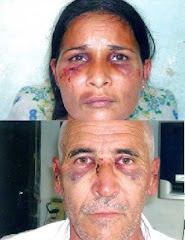By Patricia Grogg
HAVANA, Jul 11, 2011 (IPS) - "Coffee! Get your plastic bags here! Cream
cheese, the very best…!" The voices blend in with the cries of other
vendors and the noise typical of Cuban markets. Elisa, 64, was one of
the hawkers until she was fined for selling her products without a
permit. "I paid dearly for it," she says.
Someone advised Elisa to get a permit to keep selling the bags of
plastic material her niece made on a borrowed sewing machine. "But I'm
too old for that. And what do I do afterwards if I can't pay the taxes?"
she wonders. Without waiting for an answer, she disappears among the
customers appraising prices and quality among the different stands at
the farmers' market.
Alejandrina is another self-employed worker who began sewing clothes for
her friends 10 years ago. "So far, nobody's told me I have to register
as a self-employed worker. I can't decide whether I should do so,
because the taxes are sky-high," she comments.
In contrast, Felicia obtained her hairdresser's licence in the 1990s,
and says "it's business as usual" for her.
In the first quarter of this year, about 300,000 people in this country
of 11.2 million moved from the state sector to the private sector, in
light of the expansion of self-employment from 157 to 178 trades and
activities and the drastic reduction of the state payroll. The
authorities hope to encourage more people to apply for permits for
self-employment, with rules aimed at easing the tax burden.
Self-employment first began to be allowed during the severe crisis that
shook the country in the 1990s following the collapse of the socialist camp.
Registered self-employed workers jumped from 50,000 to 121,000 in 1994,
one year after a decree-law authorised its expansion. The highest number
of officially registered workers was 165,000 in 2005. However, according
to researchers, the growth of the sector was limited by a large number
of restrictions.
"The weak legal framework for the self-employed to effectively carry out
their activities has led them to subsist in a state of illegality," say
Cuban economists Omar Everleny Pérez Villanueva and Pável Vidal, in an
extensive study on the issue.
This sphere of activity, moreover, was marked by its supposedly
temporary nature and an ideologically-based wariness of it in the
context of Cuba's socialist economic and political system.
In the 1990s, many women took advantage of the non-state economic
sector, but generally in subordinate roles as helpers who were family
members, often without any remuneration whatsoever, and as such they
remained essentially invisible. According to official figures, as of
2007 women made up about one-fourth of registered self-employed workers.
According to experts on the issue, during this second wave of reforms in
self-employed work, the existing precarious informal sector, made up
mainly of women, could grow.
The most visible self-employed workers are the higher earners, who are a
minority in the sector. "The list of permitted trades, moreover, mainly
includes activities traditionally associated with men," said one source.
In that respect, Professor Luisa Iñiguez notes that in Havana, where the
economically-active female population is almost 50 percent of the total,
only 38 percent of self-employment applications had been presented by
women as of Jan. 31.
This figure already indicates a disadvantage in terms of women becoming
involved in self-employment, commented Iñiguez, consulted by IPS during
a seminar organised by the Centre for the Study of the Cuban Economy,
and jointly supported by the Friedrich Ebert Foundation and the Swiss
Agency for Development and Cooperation.
Through simple observation, it may be seen that in the self-employed
sector women hold occupations traditionally considered as feminine. In
that sense, they may be seen more frequently as food processors and
vendors, landladies (renting rooms), embroiderers, knitters and weavers,
manicurists, hairdressers, nannies and domestic workers.
Women's remunerated work is concentrated fundamentally in the state and
civil sector, where they comprise 42.7 percent of the total. In 2009,
women made up 59 percent of administrative personnel, according to the
National Office of Statistics.
The greater opening and flexibility in the self-employed sector is part
of the reforms of the so-called "updating" of Cuba's economic model, and
was designed by the government to help create alternatives to the
cutting of more than one million state jobs between 2011 and 2015. The
original schedule for those cuts, which began last October, has been
postponed.
According to Pérez Villanueva and Vidal, "the original estimates
apparently did not anticipate, among other elements, that the legal
spaces opened for self-employment could be filled before the
rationalisation (reduction) of state employment materialised, by people
who were not previously employed, were retired, and/or were already
carrying out these activities informally."
Statistical data quoted in the study show that 68 percent of the 221,839
new permits granted and being processed as of April belonged to people
who were not previously employed, and 16 percent belonged to retirees
and state workers. Neither the official reports nor the article by the
two economists provides data broken down by gender.
Many permits, moreover, have been granted to people who were already
self-employed, but without authorisation. Pérez Villanueva and Vidal
agree that microcredit and the wholesale supply market, key to the
growth of the non-state sector, could also encourage people to apply for
permits, because to have access to them, self-employed workers must be
registered and pay taxes.
Other analysts warn that while women make up nearly 65 percent of
university graduates and 66 percent of the country's technical and
professional workforce, the options available to them for private work
are as precarious and unskilled as they are for men. In fact, only seven
percent of the permits granted as of April went to university graduates.

No comments:
Post a Comment